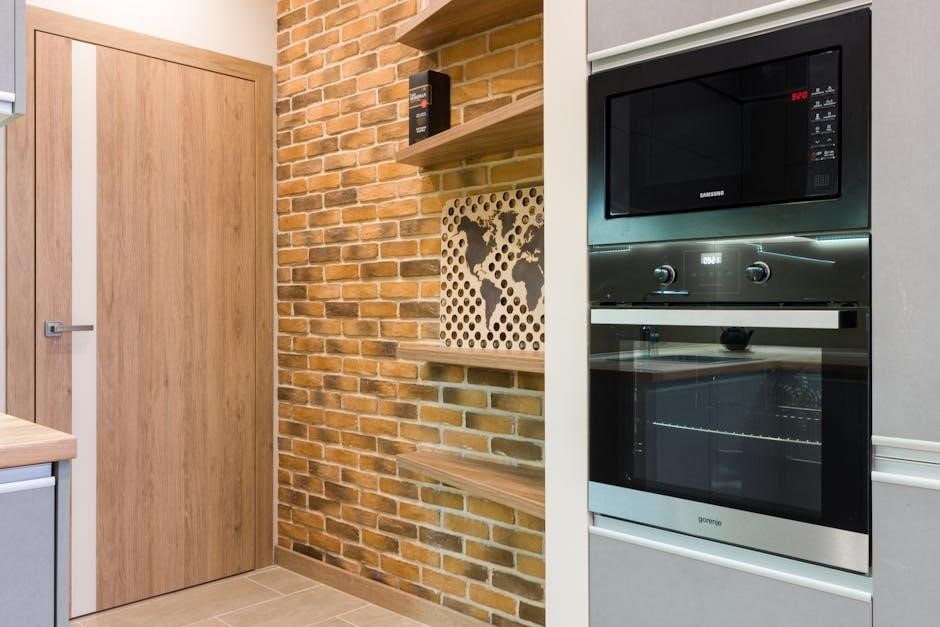Manual brakes rely on driver input to activate the braking mechanism without power assistance‚ offering reliable control for vehicles‚ especially in situations requiring precise stopping power․
1․1 Definition and Purpose of Manual Brakes
Manual brakes are a type of braking system that relies solely on the driver’s physical input to activate the brakes‚ without the assistance of power boosters․ The primary purpose of manual brakes is to provide a reliable and straightforward method of slowing down or stopping a vehicle by directly engaging the braking mechanism through a pedal or lever․ This system is often preferred for its simplicity‚ as it eliminates the need for complex hydraulic or electronic components․ Manual brakes are particularly valued in classic cars and vehicles where maintaining originality is important․ They also offer a higher degree of control for experienced drivers‚ allowing for precise modulation of braking force․ While they require more effort to operate compared to power-assisted brakes‚ manual brakes are known for their durability and lower maintenance costs․ Additionally‚ they serve as a crucial safety feature‚ ensuring the vehicle can always be brought to a stop even in the absence of auxiliary systems․

1․2 Brief History of Manual Braking Systems
Manual braking systems have a long history dating back to the early days of automotive development․ Initially‚ braking systems were entirely mechanical‚ relying on levers and cables to apply pressure directly to the brake shoes or pads․ This simplicity made manual brakes the standard for many decades‚ especially in simpler vehicles and classic cars․ Over time‚ hydraulic systems replaced purely mechanical setups‚ improving efficiency and reliability․ However‚ manual brakes retained their popularity in certain niches‚ such as vintage automobiles and performance vehicles‚ where drivers appreciated the direct control they offered․ Even with the advent of power-assisted brakes‚ manual systems remained relevant for their simplicity‚ lower maintenance‚ and nostalgic appeal․ Today‚ manual brakes are often sought after for restorations and custom builds‚ bridging the gap between traditional automotive engineering and modern driving experiences․

Components of Manual Brake Systems
Manual brake systems consist of a brake pedal‚ master cylinder‚ slave cylinders‚ brake lines‚ hoses‚ brake fluid‚ and reservoir‚ working together to apply stopping force to the vehicle’s wheels․
2․1 Brake Pedal and Linkage

The brake pedal and linkage are the initial components in a manual brake system‚ converting driver input into mechanical force․ The pedal is typically located on the far left of the footwell and is connected via a linkage system to the master cylinder․ When pressed‚ the pedal leverages the driver’s foot pressure to create the necessary force for braking․ The linkage ensures a direct and precise connection between the pedal and the master cylinder‚ eliminating any sponginess or delay in brake activation․ This mechanical connection is a defining feature of manual brakes‚ providing drivers with a tactile and responsive braking experience․ The simplicity of this setup reduces reliance on external power sources‚ making it both reliable and straightforward to maintain․
2․2 Master Cylinder and Slave Cylinders
The master cylinder is the heart of the manual brake system‚ converting non-hydraulic pedal pressure into hydraulic force․ When the brake pedal is pressed‚ it actuates the master cylinder‚ which displaces brake fluid through the brake lines to the slave cylinders․ Slave cylinders‚ located near each brake assembly‚ translate this hydraulic pressure into mechanical force‚ pushing the brake pads or shoes against the rotors or drums to slow or stop the vehicle․ The master cylinder ensures consistent pressure distribution‚ while the slave cylinders execute the physical actuation of the brakes․ Together‚ they form a reliable and efficient system‚ essential for safe and controlled braking in vehicles equipped with manual brakes․ Proper maintenance of these components is critical to ensure optimal braking performance and safety․
2․3 Brake Lines and Hoses
Brake lines and hoses are critical components of manual brake systems‚ responsible for transmitting hydraulic pressure from the master cylinder to the slave cylinders․ Brake lines are typically made of durable steel or reinforced materials to withstand pressure and environmental factors‚ while flexible rubber hoses are used near moving components like wheels to accommodate suspension travel․ These lines and hoses must be free from damage‚ corrosion‚ or leaks to ensure consistent brake performance․ Proper installation and routing are essential to prevent damage from heat‚ abrasion‚ or mechanical stress․ Regular inspection of brake lines and hoses is vital for safety‚ as any compromise in their integrity can lead to a loss of braking efficiency or complete system failure․ Replacing worn or damaged components promptly is crucial to maintain reliable vehicle control․
2․4 Brake Fluid and Reservoir
Brake fluid is the lifeblood of manual brake systems‚ transmitting pressure from the master cylinder to the slave cylinders․ The reservoir holds the fluid‚ ensuring a consistent supply․ Brake fluid must meet specific standards to maintain viscosity and prevent boiling under heat․ Regular checks are essential to ensure proper fluid levels and prevent contamination or degradation‚ which can lead to system failure․ The reservoir is typically translucent‚ allowing easy monitoring‚ and has a cap to seal out moisture and debris․ Over time‚ brake fluid can absorb moisture‚ leading to reduced performance‚ so periodic replacement is recommended․ Maintaining clean‚ high-quality brake fluid ensures reliable braking performance and prevents corrosion within the system․ Proper management of brake fluid is crucial for the longevity and effectiveness of manual brakes․ Always use the recommended type and avoid mixing different grades․ Regular maintenance ensures optimal functionality and safety․

How Manual Brakes Work
Manual brakes function through a mechanical system where pressing the pedal activates the master cylinder‚ which transmits pressure via brake lines to the slave cylinders‚ effectively engaging the brakes․
3․1 Mechanism of Manual Brake Activation
Manual brake activation begins when the driver presses the brake pedal‚ which is connected to a linkage system․ This linkage transfers the mechanical force to the master cylinder‚ converting non-hydraulic pressure into hydraulic pressure․ The master cylinder then sends this pressure through brake lines and hoses to the slave cylinders located near each wheel․ The slave cylinders receive the hydraulic pressure and push the brake pads or shoes against the rotors or drums‚ creating friction that slows the vehicle․ This process relies solely on mechanical and hydraulic components without any power assistance‚ ensuring a direct and reliable braking action․ The simplicity of this mechanism makes manual brakes durable and less prone to failure compared to power-assisted systems‚ offering drivers consistent control over their vehicle’s stopping power․
3․2 Advantages of Manual Brakes Over Power Brakes
Manual brakes offer several advantages over power-assisted systems‚ primarily in their simplicity and reliability․ Unlike power brakes‚ manual systems do not rely on complex electrical or hydraulic components‚ reducing the risk of failure and making them easier to maintain․ This simplicity also translates to cost savings‚ as manual brakes require fewer parts and less labor to install or repair․ Additionally‚ manual brakes provide a more direct and tangible connection to the braking process‚ giving drivers greater control and feedback․ They are particularly advantageous in lightweight or classic vehicles‚ where the absence of heavy power-assisted components can enhance overall performance․ Furthermore‚ manual brakes are less prone to issues caused by power loss or system malfunctions‚ making them a dependable choice for drivers seeking a straightforward and efficient braking solution․
3․3 Common Configurations in Vehicles
Manual brakes are commonly configured in vehicles as a straightforward‚ non-power-assisted system‚ often found in lightweight or classic cars․ These configurations typically involve a single-circuit setup‚ where the brake pedal directly activates the master cylinder‚ distributing hydraulic pressure to the slave cylinders at each wheel․ In some cases‚ especially in older models‚ a dual-circuit configuration may be employed for enhanced safety‚ ensuring that if one part of the system fails‚ the other remains operational․ Additionally‚ manual brakes are frequently paired with drum or disc brakes‚ depending on the vehicle’s design and performance requirements․ This configuration is favored for its simplicity‚ reliability‚ and cost-effectiveness‚ making it a practical choice for drivers who prefer a more traditional and hands-on approach to braking․ Such setups are also popular among enthusiasts who value the tactile feedback and control offered by manual systems․

Maintenance and Troubleshooting
Regular inspection of brake fluid levels‚ worn pads‚ and hydraulic leaks is essential․ Addressing issues promptly prevents system failure and ensures reliable braking performance over time․
4․1 Regular Inspection and Maintenance Tips
Regular inspection ensures manual brakes function optimally․ Check brake fluid levels‚ inspect brake pads for wear‚ and test brake lines for leaks or damage․ Bleeding the system annually prevents air bubbles that reduce braking efficiency․ Lubricate pivot points to maintain smooth pedal operation․ Inspect the master cylinder for signs of corrosion or wear․ Test the brake pedal for firmness; a spongy feel indicates potential issues․ Replace worn components promptly to avoid system failure․ Always use high-quality brake fluid and follow manufacturer guidelines․ Regular maintenance not only enhances safety but also extends the lifespan of the braking system‚ ensuring reliable performance in all driving conditions․ Consistency in these checks helps identify and address problems early‚ preventing costly repairs down the line․

4․2 Bleeding the Brake System
Bleeding the brake system is essential to remove air bubbles that can compromise braking efficiency․ Start by gathering the necessary tools: a brake bleeding kit‚ brake fluid‚ and a clean container․ Open the brake reservoir and pour in fresh fluid‚ ensuring it meets the manufacturer’s specifications․ Attach the bleeding kit to the reservoir and pump the brake pedal gently to circulate the fluid․ Check each slave cylinder for air bubbles and repeat the process until the fluid flows freely without bubbles․ Use a wrench to open the bleeder valves and allow the fluid to drain into a pan․ Close the valves tightly after each use to prevent air from re-entering․ Regular bleeding ensures a firm pedal feel and consistent stopping power‚ making it a critical maintenance step for manual brakes․

4․3 Common Issues and Solutions
Manual brake systems can encounter issues like spongy brake pedals‚ excessive pedal travel‚ or inconsistent braking performance․ Air in the brake lines is a common culprit‚ requiring system bleeding to resolve․ Brake fluid leaks‚ often due to worn seals or damaged lines‚ can lead to a soft pedal and reduced braking efficiency․ Inspecting and replacing faulty components promptly is crucial․ Another issue is worn brake pads or shoes‚ which can cause reduced stopping power․ Replacing these components ensures proper friction and reliable braking․ Additionally‚ misaligned brake shoes or drums can lead to uneven wear and poor braking performance‚ requiring adjustment or replacement․ Regular maintenance and inspections help identify and address these issues early‚ ensuring optimal braking reliability and safety․

Upgrading and Customizing Manual Brakes
Upgrading manual brakes often involves switching to dual-circuit systems for enhanced reliability or adding a brake booster for improved stopping power and pedal feel‚ especially in classic cars․
5․1 Upgrading to Dual-Circuit Brake Systems
Upgrading to a dual-circuit brake system is a significant enhancement for manual brakes‚ offering improved safety and reliability․ This system comprises two independent circuits‚ ensuring that if one fails‚ the other continues to function‚ preventing complete brake failure․ The upgrade involves installing a dual-chamber master cylinder‚ separate brake lines‚ and additional slave cylinders․ This configuration allows for better distribution of braking force between the front and rear wheels‚ leading to enhanced stopping performance․ Additionally‚ it provides redundancy‚ which is crucial for safety‚ especially in classic cars where original systems may lack modern safeguards․ Drivers who prefer the control of manual brakes can benefit from this upgrade‚ enjoying the best of both worlds: traditional feel with advanced reliability․
5․2 Adding a Brake Booster for Improved Performance
Adding a brake booster enhances manual brake performance by amplifying the pressure applied to the brake pedal‚ reducing effort and improving responsiveness․ Typically vacuum-assisted‚ it uses engine suction to multiply pedal force‚ making braking easier and more efficient․ This upgrade is particularly beneficial for vehicles with heavy brake systems or those requiring consistent pedal feel․ While traditional manual brakes rely solely on driver strength‚ a booster bridges the gap‚ offering modern performance without switching to power brakes․ It’s a popular modification for classic cars and drivers who prefer the control of manual brakes but seek improved stopping power․ The booster integrates seamlessly with existing components‚ ensuring reliability and maintaining the manual braking experience while enhancing overall safety and driver confidence․
5․3 Custom Brake Upgrades for Classic Cars
Custom brake upgrades for classic cars allow owners to enhance performance while preserving the vehicle’s original character․ Many classic car enthusiasts opt for dual-circuit brake systems‚ which improve safety by splitting the braking system into two independent circuits․ This modification reduces the risk of complete brake failure․ Additionally‚ installing a brake booster can significantly enhance braking efficiency‚ making it easier to stop the vehicle with less pedal effort․ For those seeking a more modern feel‚ upgrading to disc brakes or high-performance calipers is a popular choice․ These upgrades often require custom fabrication to ensure compatibility with the classic car’s existing chassis and suspension․ Consulting with a specialist is crucial to ensure the modifications are both functional and visually consistent with the car’s timeless design․ Such upgrades not only improve safety but also maintain the vehicle’s vintage appeal․

Safety Considerations
Proper use of manual brakes requires smooth‚ gradual application to avoid skidding․ Regular inspections ensure reliable performance‚ while understanding emergency techniques enhances control and safety on the road․
6․1 Proper Use of Manual Brakes for Safe Driving
Manual brakes require a firm yet controlled touch to ensure safe driving․ Drivers should apply steady pressure‚ avoiding sudden jerks that might cause skidding․ Proper use involves smooth deceleration‚ especially on wet or uneven surfaces․ Always maintain a safe distance from the vehicle ahead to allow ample stopping time․ It’s crucial to avoid riding the brake‚ as this can overheat the system․ Additionally‚ drivers should be mindful of their vehicle’s weight distribution and speed when braking․ Regular practice in a safe environment helps develop muscle memory for effective braking․ By mastering these techniques‚ drivers can enhance their safety on the road while using manual brakes effectively․
6․2 Emergency Brake Techniques
In emergency situations‚ proper manual brake technique is critical․ Drivers should apply firm‚ steady pressure to the brake pedal without slamming on the brakes‚ which can cause skidding․ Threshold braking‚ where the pedal is pressed to the point just before wheel lock-up‚ maximizes stopping power․ For vehicles without anti-lock braking systems (ABS)‚ cadence braking (pumping the brakes) can help maintain control․ Staying calm and focused ensures precise pedal control․ It’s also important to downshift before braking‚ especially in manual transmission vehicles‚ to reduce speed effectively․ Practicing these techniques in a controlled environment builds the reflexes needed for real emergencies․ Knowing your vehicle’s braking characteristics is key to executing emergency stops safely and efficiently․
Manual brakes remain a reliable and essential braking system‚ emphasizing driver control and mechanical simplicity․ Their evolution continues to balance tradition with modern advancements‚ ensuring safety and efficiency․
7․1 Summary of Key Points
Manual brakes are a foundational braking system emphasizing driver control and mechanical simplicity․ They rely on physical input to activate brakes without power assistance‚ ensuring reliability in various driving conditions․ Key components include the brake pedal‚ master cylinder‚ slave cylinders‚ and brake fluid‚ working together to halt vehicles effectively․ Regular maintenance‚ such as inspecting brake lines and bleeding the system‚ is crucial for optimal performance․ Upgrades like dual-circuit systems and brake boosters enhance safety and efficiency․ Manual brakes are particularly popular in classic cars‚ offering a connection to traditional automotive engineering․ While modern vehicles often favor power-assisted brakes‚ manual systems remain relevant for their simplicity and effectiveness․ Their enduring presence highlights a balance between tradition and innovation in automotive technology․
7․2 Future of Manual Brake Technology
Manual brake technology continues to evolve‚ blending tradition with modern advancements․ Future developments may focus on integrating lightweight materials and improved brake fluid formulations for enhanced performance․ Dual-circuit systems are expected to become more prevalent‚ offering greater safety by reducing failure risks․ Additionally‚ advancements in brake booster technology could provide optional assistance without fully transitioning to power brakes‚ catering to enthusiasts who value manual control․ Classic car restorations will likely drive demand for custom brake upgrades‚ ensuring manual systems remain relevant․ While power-assisted brakes dominate modern vehicles‚ manual brakes will persist in niche markets‚ offering simplicity and reliability for specific driving needs and preferences․ Their enduring appeal underscores a balance between heritage and innovation in automotive engineering․






























